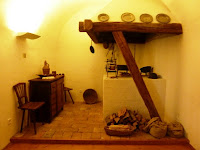 |
| close-up of unique baroque architecture of the Karlskirche, dedicated to a saint who healed plague victims (built 1716-1737) |
This organ dates from some time in the nineteenth century and has two manuals, 30 stops, and a mere octave and a half in the pedals--which means you couldn't play most of J.S. Bach's organ works on it! We spent the first twenty minutes just figuring out which stops went to which manual, how they sounded, and what kinds of combinations he could make with them. I turned pages, took photographs, and tried to remember not to fall off the big step next to the organ. We were up in the organ loft, 75 steps and I don't know how many feet from ground level.
 |
| Dear Husband at the organ |
The reactions were mixed, but mostly openly positive. I admit I was a little hesitant to dance at all (in a Catholic! church!), which is why I borrowed the t-shirt to wear instead of a strappy tank top (which is more than being naked but less than a linen ephod). But all the movements were dignified and as emotional as I could make them. Apparently I made the tenor section choke up, although they were supposed to be looking at the choir director and not at me. How's that for a European liturgical dance debut? However, one of men noted that at least one audience member was not keen on the idea of my dancing in the House of the Lord, and he wrote the following poem about it.
"Requiem" by Eliza Gilkeyson,
arranged for choir
by Craig Hella Johnson,
sung by The Chorale in Vienna
She had come to the church to worship God,
to hear a touring choir sing classics with
some spirituals--she thought the choir was good.
The young liturgical dancer was lithe,
quite serious as she embodied grief
and bafflement at death from tsunami,
earthquake, and flood.
The choir prayed for relief,
for understanding from Mother Mary.
The worshiper, offended by the dance,
looked at the floor, her eyes narrow and hard,
her jaw was clenched, her lips were white and thin.
In choir and congregation there were tears
in sympathy with grieving mother, child...
To turn away from beauty is a sin.
A Sonnet by Steve Shoemaker
June, 2012





































